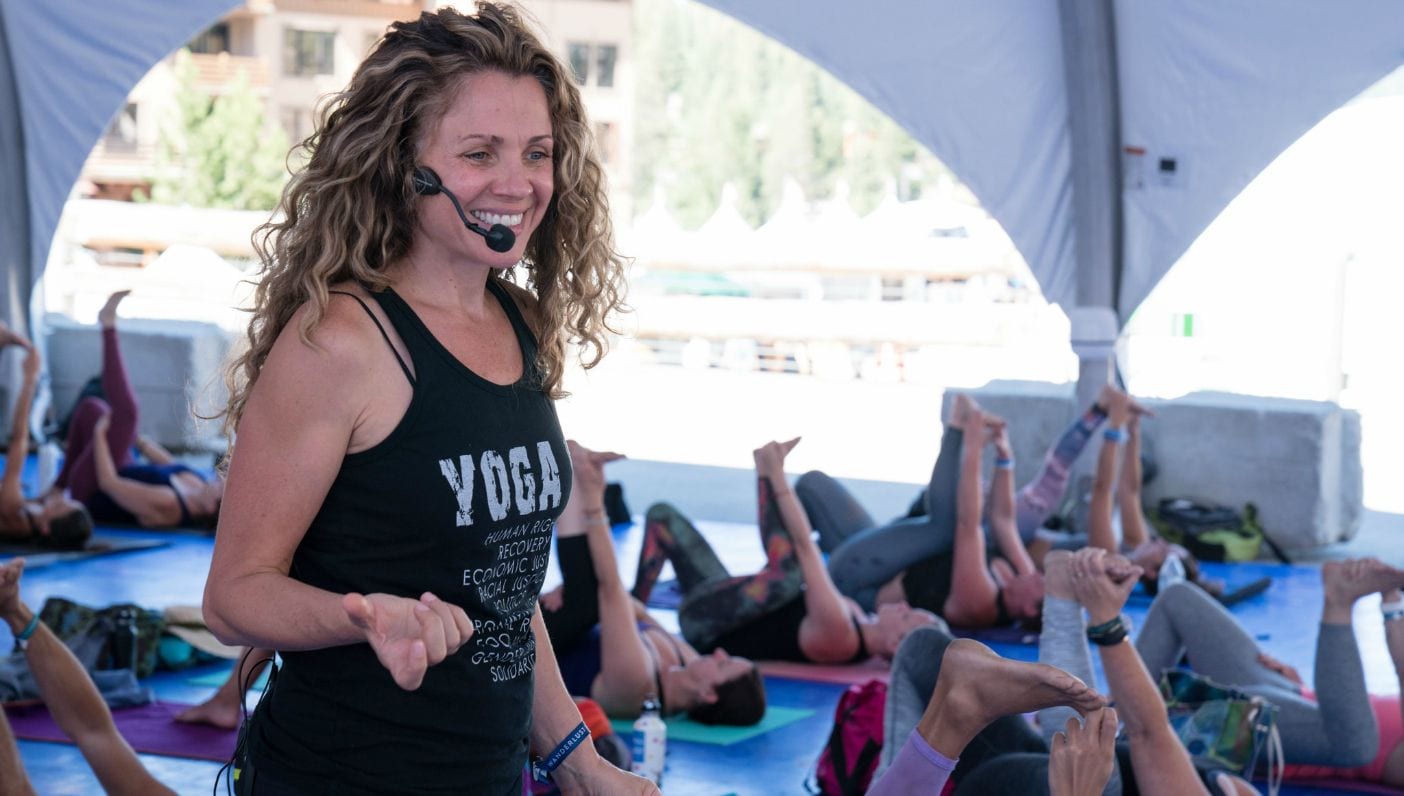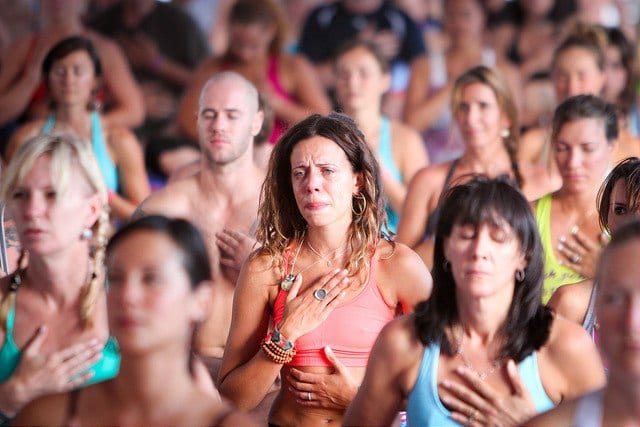
Sheri Salata and Nancy Hala are on a daring quest to make the rest of their dreams come true. Their popular podcast, “This is Fifty with Sheri and Nancy,” explores what it means to reimagine the middle of life with the help of experts in their 8 Pillars of Living: Health & Wellness, Spirituality & Happiness, Romance & Sex, Friends & Family, Creativity & Innovation, Discovery & Innovation, Sanctuary & Beauty, and Money & Abundance. Earlier this year, they welcomed world-renowned yoga teacher and activist Seane Corn onto the program to discuss the benefits of beginning a yoga practice—at any age. The following is an excerpt of that conversation. Subscribe to the podcast here.
Sheri: Seane, we were talking a little earlier that when we set our dreams for 2018 in health and wellness and spirituality, both of us dream of some sort of regular yoga practice. And you are the world-famous legend.
Nancy: That’s right. That’s the thing we like about you Seane Corn is that you have the language, you have beautiful, beautiful facility with language. And I always want to hear those words wash over us.
Seane: Thank you. I can’t imagine anything better in terms of adding this on to your pillar because yoga is such a transformative process, an experience both on a physiological level but also on an emotional psychological level that it’s transformative. And so, if you can commit even if it’s 15, 20 minutes a day, it will have such a huge impact on the way in which you react to crisis and conflict. And all it requires is just the commitment to get out of bed and do it and not have this big goal about what you think it should look like because very often what I experience from people is they see the yoga done in these classes for 90 minutes, they set these goals for themselves that are often unrealistic and then they don’t do anything.
Nancy: For sure. Well, already I have a revelation and I can just get out of bed and do it for 15 minutes like, next to my bed just do some downward facing-dog. I’m thinking to myself, “Well, I can do that.” I always make the mistake it has to be a big production in the right outfit, with the right equipment.
Seane: Yeah. We all do it, I did it too. For me, what motivates me to get out of bed and do it is because I connect the yoga practice with prayer. I wake up in the morning, I usually watch the news find out what’s going on in the world, make myself a cup of tea. And it doesn’t take long to find out whatever the crisis du jour. But once I do, I go into my room, I roll up my mat and I take a moment and I dedicate every movement and every breath of my practice to whatever that circumstance is. Or if it’s a person, I try to focus my energy on that person. And from that point forward, I just let my body be a living prayer.
And so, it doesn’t matter if it’s 15 minutes or an hour, it’s about the intention and it’s an act of service. It becomes a meditation and action. And when I’m done, I feel like I contributed to something beyond my own health and wellness. But it gives me motivation, it makes me feel purposeful.
Nancy: Wow. Now, that’s profound. See, I know you were profound from the minute I saw you when you were up on that stage. That is beautiful, you’re in service to the world and your body.
Sheri: The reason to do yoga as a spiritual practice. I like that, that really good. When did you start doing yoga?
Seane: I started doing yoga around 19. I guess it must’ve been very karmic, I lived in New York City. I moved from New Jersey to New York, and I worked downtown in the East Village at a place called Life Café. And the only reason that significant is because the owner my boss, his name is David Life and he went on to open Jivamukti Yoga. And so, the café was really awash in spirituality and health and wellness. And it’s where I learned about veganism. It’s where I learned about activism and it’s most certainly where I learned about yoga.
I got into it at that time, but really only as a physical practice. It didn’t become spiritual for me for years. I actually really resisted the chanting and anything that had to do with spirituality because I had such a negative relationship to God and I was an atheist. To me, yoga was another religion and I rejected it on principle. It took a long time for me to reframe my relationship with God, that word alone and recognize the difference between a spiritual practice and a religious practice. That’s when I began.
Sheri: I recently did a yoga for trauma class. Talk a little bit about that.
Seane: Sure. This is something that’s really important to me only because when I became a yoga teacher, I would notice in my classes taking people through an experience that people would get emotional. And I didn’t quite understand it at the time, I was was a young-
Sheri: You’re saying people start crying during yoga?
Seane: Oh, yeah. Well, it’s not just crying –
Nancy: I have seen that. I have not ever cried during yoga, but I’ve seen it in class.

Seane: People get very emotional class, but sometimes it’s not just crying. A skilled teacher observes other things that is the mask of the emotion. They fidget, look around, pick their toes in the same way that we often look for substances as a way to anesthetize ourselves or numb ourselves out from the deeper feelings. In a yoga room, you don’t have access to food or sex or drugs or alcohol… as far as I know. But what you do have is your mind and your eyes.
And so, sometimes when a student is holding a pose, they’ll look around, distract themselves or you could see they’re not breathing. And if they’re not breathing, that’s means they’re not in present time, that means your mind is engaged in something else. Other things are coming through the practitioner. I think it’s important to note that, like I said earlier, yoga is about relationship, it recognizes that everything is connected. And what bonds us is energy. Energy is defined as vibration with information. Everything has a resonance, and that includes our emotions, love and joy, you can’t see it, but you can feel it. But hate, shame, fear, grief, guilt, jealousy they all have resonance, they all have vibration.
When we experience any kind of trauma, and the trauma I like to talk about is developmental trauma because it’s the least talked about, it’s the least dramatic if you will. Wear a shock trauma, it’s immediate and you understand the impact of it. Developmental traumas are events that happen to us and aren’t the same for everyone. Trauma is defined as anything that overwhelms your capacity to cope and leaves you feeling helpless, hopeless or out of control and unable to respond. Bullying, death of a loved one, sexual abuse, divorce, all of these can be traumas that happen when we’re young that we’re fine, we move on.
But every time we experience something that reminds us of whatever that event was, we time travel. Our body actually goes back to the original –
Sheri: Like rejection or humiliation or?
Seane: Yes. Exactly. And so, what happens when we experience a trauma is actually physiological. Our brain releases chemicals, those chemicals flood into our body. That includes hormones of course and, I can remember the other one. And what happens then is we go into fight, flight, freeze or collapse and our bodies contract. That tension is what keeps us in control. That tension when we were a little kids, that’s what keeps us from feeling that overwhelm. Well, hopefully if you were raised in an environment where your mother or your father can talk you through, let you cry or rage or scream, what happens to your point is you discharge the energy.
But most the time, we don’t have a kind of upbringing. What our mother might say is, “Oh my god. You are scared or sad, here. Let’s go get some ice cream.” Or, “Oh, you’re scared or sad, let’s go to the mall and we’ll get a present.” Or, “You’re scared or sad, please, I’ll give you something to be scared or sad about.” But either way, you’re being invited to deny and suppress it. But that suppressed energy becomes the tension that we experience. And that sensation is addictive because we think it keeps us in control.
That’s why yoga so challenging. You release the tension and all of those suppressed emotions come up to the surface, and we don’t know what to do with it. In a yoga class, you fidget, you look around, you judge the teacher, you fantasize. All of a sudden the person on the mat next to you starts as your boyfriend and then you’re fantasizing having sex with them. By the end of the class, you’re married. You go through all the stuff to take you away from the discomfort. The people who have emotional experiences is because they have actually breathed into the discomfort and allowed themselves to be present to the emotion as it arises without trying to change it.
Sheri: Wow. That’s yoga.
Want more of the conversation? Check out the “This is Fifty” podcast. New episodes every week! Available on iTunes, Android, Google Play, Stitcher, and Tunein.
—